+ Open data
Open data
- Basic information
Basic information
| Entry | Database: PDB / ID: 2no3 | ||||||
|---|---|---|---|---|---|---|---|
| Title | Novel 4-anilinopyrimidines as potent JNK1 Inhibitors | ||||||
 Components Components |
| ||||||
 Keywords Keywords | SIGNALING PROTEIN/INHIBITOR / JNK1 / C-JUN N-TERMINAL KINASE / JNK1 INHIBITORS / ANILINOPYRIMIDINES JNK1 INHIBITORS / SIGNALING PROTEIN-INHIBITOR COMPLEX | ||||||
| Function / homology |  Function and homology information Function and homology informationJUN phosphorylation / positive regulation of cell killing / Activation of BMF and translocation to mitochondria / Interleukin-38 signaling / basal dendrite / positive regulation of establishment of protein localization to mitochondrion / Activation of BIM and translocation to mitochondria / WNT5:FZD7-mediated leishmania damping / positive regulation of cyclase activity / histone deacetylase regulator activity ...JUN phosphorylation / positive regulation of cell killing / Activation of BMF and translocation to mitochondria / Interleukin-38 signaling / basal dendrite / positive regulation of establishment of protein localization to mitochondrion / Activation of BIM and translocation to mitochondria / WNT5:FZD7-mediated leishmania damping / positive regulation of cyclase activity / histone deacetylase regulator activity / NRAGE signals death through JNK / positive regulation of NLRP3 inflammasome complex assembly / Activation of the AP-1 family of transcription factors / Fc-epsilon receptor signaling pathway / positive regulation of protein metabolic process / JUN kinase activity / mitogen-activated protein kinase / regulation of macroautophagy / response to UV / response to mechanical stimulus / stress-activated MAPK cascade / energy homeostasis / JNK cascade / protein serine/threonine kinase binding / negative regulation of protein binding / peptidyl-threonine phosphorylation / cellular response to amino acid starvation / NRIF signals cell death from the nucleus / JNK (c-Jun kinases) phosphorylation and activation mediated by activated human TAK1 / cellular response to reactive oxygen species / FCERI mediated MAPK activation / regulation of circadian rhythm / histone deacetylase binding / cellular response to mechanical stimulus / cellular senescence / Signaling by ALK fusions and activated point mutants / rhythmic process / Recruitment and ATM-mediated phosphorylation of repair and signaling proteins at DNA double strand breaks / regulation of protein localization / peptidyl-serine phosphorylation / cellular response to lipopolysaccharide / cellular response to oxidative stress / protein phosphatase binding / Oxidative Stress Induced Senescence / response to oxidative stress / protein phosphorylation / positive regulation of apoptotic process / axon / protein serine kinase activity / protein serine/threonine kinase activity / synapse / positive regulation of gene expression / negative regulation of apoptotic process / enzyme binding / nucleoplasm / ATP binding / nucleus / cytosol / cytoplasm Similarity search - Function | ||||||
| Biological species |  Homo sapiens (human) Homo sapiens (human) | ||||||
| Method |  X-RAY DIFFRACTION / X-RAY DIFFRACTION /  MOLECULAR REPLACEMENT / Resolution: 3.2 Å MOLECULAR REPLACEMENT / Resolution: 3.2 Å | ||||||
 Authors Authors | Abad-Zapatero, C. | ||||||
 Citation Citation |  Journal: Bioorg.Med.Chem.Lett. / Year: 2007 Journal: Bioorg.Med.Chem.Lett. / Year: 2007Title: Discovery of a new class of 4-anilinopyrimidines as potent c-Jun N-terminal kinase inhibitors: Synthesis and SAR studies. Authors: Liu, M. / Wang, S. / Clampit, J.E. / Gum, R.J. / Haasch, D.L. / Rondinone, C.M. / Trevillyan, J.M. / Abad-Zapatero, C. / Fry, E.H. / Sham, H.L. / Liu, G. #1:  Journal: Bioorg.Med.Chem.Lett. / Year: 2006 Journal: Bioorg.Med.Chem.Lett. / Year: 2006Title: Synthesis and SAR of 1,9-dihydro-9-hydroxypyrazolo[3,4-b]quinolin-4-ones as novel, selective c-Jun N-terminal kinase inhibitors. Authors: Liu, M. / Xin, Z. / Clampit, J.E. / Wang, S. / Gum, R.J. / Haasch, D.L. / Trevillyan, J.M. / Abad-Zapatero, C. / Fry, E.H. / Sham, H.L. #2:  Journal: J.Med.Chem. / Year: 2006 Journal: J.Med.Chem. / Year: 2006Title: Selective aminopyridine-based C-Jun N-terminal kinase inhibitors with cellular activiy Authors: Szczepankiewicz, B.G. / Kosogof, C. / Nelson, L.T.J. / Liu, G. / Zhao, H. / Serby, M.D. / Xin, Z. / Liu, B. / Gum, R.J. / Haasch, D. #3:  Journal: J.Med.Chem. / Year: 2006 Journal: J.Med.Chem. / Year: 2006Title: Discovery of Potent, Highly Selective and orally bioavailable Pyridine Carboxamide C-jun NH2-terminal kinase inhibitors Authors: Zhao, H. / Serby, M.D. / Xin, Z. / Szczepankiewicz, B.G. / Liu, M. / Kosogof, C. / Liu, B. / Gum, R.J. / Clampit, J.E. / Haasch, D.L. | ||||||
| History |
| ||||||
| Remark 999 | SEQUENCE THE NATIVE, UNMUTATED SEQUENCE IS THE SAME AS THE P45983-2 ISOFORM. THE INTRODUCED ...SEQUENCE THE NATIVE, UNMUTATED SEQUENCE IS THE SAME AS THE P45983-2 ISOFORM. THE INTRODUCED MUTATIONS (THR183>GLU, TYR185>GLU) ARE INTENDED TO MIMIC THE ACTIVATED FORM OF THE KINASE UPON PHOSPHORYLATION OF THOSE TWO RESIDUES. |
- Structure visualization
Structure visualization
| Structure viewer | Molecule:  Molmil Molmil Jmol/JSmol Jmol/JSmol |
|---|
- Downloads & links
Downloads & links
- Download
Download
| PDBx/mmCIF format |  2no3.cif.gz 2no3.cif.gz | 160.7 KB | Display |  PDBx/mmCIF format PDBx/mmCIF format |
|---|---|---|---|---|
| PDB format |  pdb2no3.ent.gz pdb2no3.ent.gz | 128.1 KB | Display |  PDB format PDB format |
| PDBx/mmJSON format |  2no3.json.gz 2no3.json.gz | Tree view |  PDBx/mmJSON format PDBx/mmJSON format | |
| Others |  Other downloads Other downloads |
-Validation report
| Arichive directory |  https://data.pdbj.org/pub/pdb/validation_reports/no/2no3 https://data.pdbj.org/pub/pdb/validation_reports/no/2no3 ftp://data.pdbj.org/pub/pdb/validation_reports/no/2no3 ftp://data.pdbj.org/pub/pdb/validation_reports/no/2no3 | HTTPS FTP |
|---|
-Related structure data
| Related structure data |  2h96S S: Starting model for refinement |
|---|---|
| Similar structure data |
- Links
Links
- Assembly
Assembly
| Deposited unit | 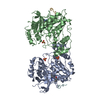
| ||||||||
|---|---|---|---|---|---|---|---|---|---|
| 1 | 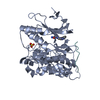
| ||||||||
| 2 | 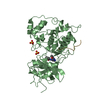
| ||||||||
| 3 |
| ||||||||
| Unit cell |
|
- Components
Components
| #1: Protein | Mass: 42919.559 Da / Num. of mol.: 2 / Fragment: JNK1 residues 1-364 / Mutation: T183E, Y183E Source method: isolated from a genetically manipulated source Source: (gene. exp.)  Homo sapiens (human) / Gene: MAPK8, JNK1, PRKM8 / Plasmid: PET28A / Production host: Homo sapiens (human) / Gene: MAPK8, JNK1, PRKM8 / Plasmid: PET28A / Production host:  References: UniProt: P45983, mitogen-activated protein kinase #2: Protein/peptide | Mass: 1345.612 Da / Num. of mol.: 2 / Fragment: PEPJIP1 PEPTIDE / Source method: obtained synthetically / Details: The sequence is found naturally in homo sapiens #3: Chemical | ChemComp-SO4 / #4: Chemical | |
|---|
-Experimental details
-Experiment
| Experiment | Method:  X-RAY DIFFRACTION / Number of used crystals: 1 X-RAY DIFFRACTION / Number of used crystals: 1 |
|---|
- Sample preparation
Sample preparation
| Crystal | Density Matthews: 4.97 Å3/Da / Density % sol: 75.24 % |
|---|---|
| Crystal grow | Temperature: 277 K / Method: vapor diffusion / pH: 6.2 Details: PROTEIN WAS PREINCUBATED WITH THE JIP1 PEPTIDE AT A 5X MOLAR EXCESS. PROTEIN CONCENTRATION 9- 12.6 MG/ML. HANGING DROPS CONSISTED OF 2UL PROTEIN PLUS 2 UL WELL SOLUTION. WELL SOLUTION:2.8-3. ...Details: PROTEIN WAS PREINCUBATED WITH THE JIP1 PEPTIDE AT A 5X MOLAR EXCESS. PROTEIN CONCENTRATION 9- 12.6 MG/ML. HANGING DROPS CONSISTED OF 2UL PROTEIN PLUS 2 UL WELL SOLUTION. WELL SOLUTION:2.8-3.1 M AMMONIUM SULFATE, 10- 14% GLYCEROL. FOR CO-CRYSTALLIZATION EXPERIMENT WITH THE COMPOUND, THE COMPOUND WAS DISSOLVED IN DMSO AT 100 MM CONCENTRATION. ALLOW TO INCUBATE FOR AT LEAST AN HOUR ON ICE. SOLUTION WAS SPUN FOR 5 MINUTES AT 2000G PRIOR TO SETTING UP FOR CRYSTALLIZATION., pH 6.20, VAPOR DIFFUSION, temperature 277.0K |
-Data collection
| Diffraction | Mean temperature: 110 K |
|---|---|
| Diffraction source | Source:  ROTATING ANODE / Type: RIGAKU RU300 / Wavelength: 1.5418 Å ROTATING ANODE / Type: RIGAKU RU300 / Wavelength: 1.5418 Å |
| Detector | Type: MAR CCD 165 mm / Detector: CCD / Date: Jan 6, 2005 / Details: Osmic Mirrors |
| Radiation | Protocol: SINGLE WAVELENGTH / Monochromatic (M) / Laue (L): M / Scattering type: x-ray |
| Radiation wavelength | Wavelength: 1.5418 Å / Relative weight: 1 |
| Reflection | Resolution: 3.2→20 Å / Num. all: 28588 / Num. obs: 27814 / % possible obs: 94.5 % / Observed criterion σ(I): 1 / Redundancy: 5.6 % / Biso Wilson estimate: 36.8 Å2 / Rmerge(I) obs: 0.083 / Rsym value: 0.083 / Net I/σ(I): 15.3 |
| Reflection shell | Resolution: 3.2→3.31 Å / Redundancy: 4.2 % / Rmerge(I) obs: 0.454 / Mean I/σ(I) obs: 1.6 / Num. unique all: 2866 / Rsym value: 0.812 / % possible all: 98.3 |
- Processing
Processing
| Software |
| |||||||||||||||||||||||||
|---|---|---|---|---|---|---|---|---|---|---|---|---|---|---|---|---|---|---|---|---|---|---|---|---|---|---|
| Refinement | Method to determine structure:  MOLECULAR REPLACEMENT MOLECULAR REPLACEMENTStarting model: entry 2h96 Resolution: 3.2→19.98 Å / Rfactor Rfree error: 0.006 / Data cutoff high absF: 162862.68 / Data cutoff low absF: 0 / Isotropic thermal model: RESTRAINED / Cross valid method: THROUGHOUT / σ(F): 2 / Stereochemistry target values: Engh & Huber
| |||||||||||||||||||||||||
| Solvent computation | Solvent model: FLAT MODEL / Bsol: 24.1807 Å2 / ksol: 0.224291 e/Å3 | |||||||||||||||||||||||||
| Displacement parameters | Biso mean: 65.1 Å2
| |||||||||||||||||||||||||
| Refine analyze |
| |||||||||||||||||||||||||
| Refinement step | Cycle: LAST / Resolution: 3.2→19.98 Å
| |||||||||||||||||||||||||
| Refine LS restraints |
| |||||||||||||||||||||||||
| LS refinement shell | Resolution: 3.2→3.31 Å / Rfactor Rfree error: 0.027 / Total num. of bins used: 10
| |||||||||||||||||||||||||
| Xplor file |
|
 Movie
Movie Controller
Controller








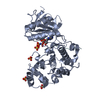
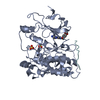

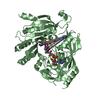
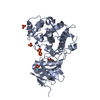


 PDBj
PDBj









